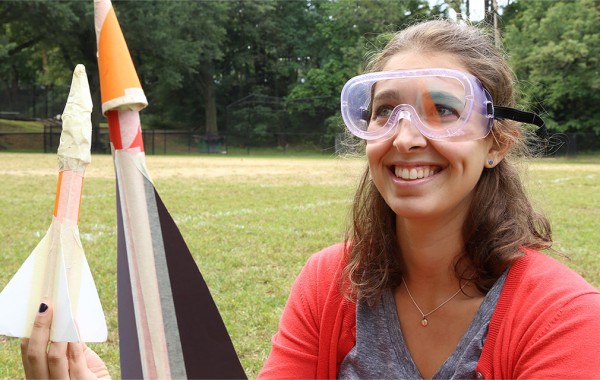
Jenna Glat ’14
At the intersection of geography and the environment, Jenna Glat ’14 found her interest in helping people live better lives. Last spring, Glat was chosen as a fellow for the 2014 Summer of Maps program through Azavea, a geographic data web software company. She spent the summer working alongside two other fellows, both master’s students, conducting pro bono geospatial analysis for nonprofit organizations in Philadelphia, Pa.
During her Philadelphia-based fellowship, Glat, a geography major, melded her interests in mapping and green energy when she provided free statistical analysis of geographic data for the nonprofit organizations TreePeople and The Consortium for Building Energy Innovation. Both organizations work to understand how green energy and harnessing the power of nature can improve communities across the country.
“For TreePeople, I studied how health variables and socioeconomic factors tie to tree cover in areas of Los Angeles,” explained Glat. “I took tree cover data and information from hospital sources and the census bureau and put it all together on a map. I found that outside of LA, the richer suburbs have more tree cover and fewer health problems than poorer areas of downtown LA, which have fewer trees and more health problems.” Her work identified where increased tree planting would provide the greatest health benefits for citizens of Los Angeles, information that can give direction to future green initiatives in the city.
Her project for The Consortium for Building Energy Innovation focused on studying energy efficiency among commercial buildings in five major cities across the country. “I plotted buildings on a map and studied data on their energy use and greenhouse gas emissions as well as information from the census bureau on population numbers to find the most energy-efficient areas of the cities,” Glat said. “It was a forty-map project.” Her work analyzed which areas in these cities are excelling and which ones could profit from adopting more energy-efficient practices that would benefit their own upkeep as well as the surrounding communities.
While at Colgate, Glat became interested in how understanding the relationship between geography and the environment can help people live healthier lives. Glat explored the human element of her major while assisting geography professor Maureen Hays-Mitchell with her research into human geography — the study of how people, places, and cultures connect. An internship experience at Pardee Resources, a land research and solar energy research company, piqued her interest in sustainability and renewable energy, an interest she later pursued as an intern in the Office of Sustainability at Colgate.
Now, Glat is helping people better understand science and the environment as an intern in the education department at National Geographic, where she produces and packages educational media content. During a recent project, Glat played the part of the student on an educational video shoot that explained how students can make bottle rockets (pictured).
She said that her experience as a Summer of Maps fellow helped her add a human element to her interest in geography and the environment, which she had only dipped into previously. It also gave her a direction as she maps out her future. “After my internship ends, I want to enter the realm of urban planning or city work, where I can use my GIS skills and also interact with people,” said Glat. “I’d really like to be out there making a positive influence on the community.”
— article by Natalie Sportelli ’15; photo courtesy of National Geographic






